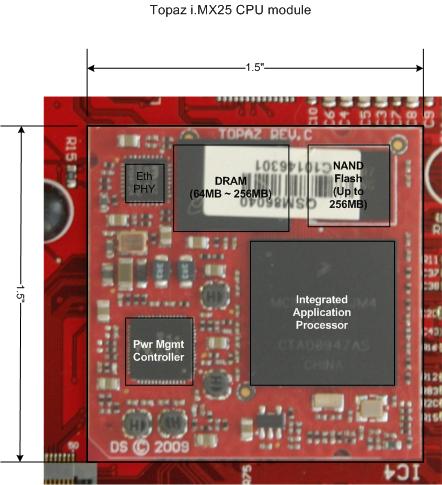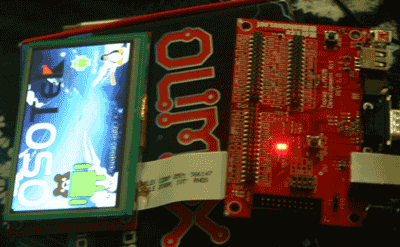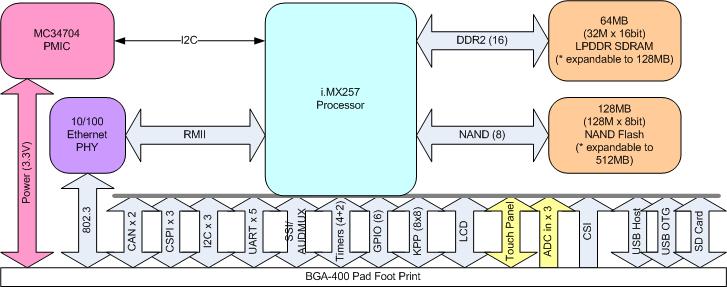 |
OSOTek
Reference Design Technical Information
|
|
Basic Reference Design
(Topaz)
FAQ Page
|
 |
The base design for the low cost ANDROID platform is a ready-made module called Topaz, produced by Device Solutions.
Actually, the project started out as an independent design utilizing FPGA, but the idea failed in terms of low cost implementation that brings a reasonable performance. It was difficult to achieve a level of CPU performance good enough to run the GUI using a reasonably priced FPGA.
It was decided that an integrated applications processor such as Freescale's i.MX25 series represent a better value. And since its pin-out and interconnects are so straightforward, a reference design comes out virtually identical no matter who you are.
Therefore we decided to take advantage of existing platform with a good features / functionalities and cost.
This module from Device Solutions satisfied those requiremetn the best.
|
| When it comes to a stand-alone embedded system, Freescale i.MX257 processor represents an incredible value. The diagram below shows the built-in function blocks of the device. |
|
|
| The device comes in a BGA 400 package, and not all functions are available at the same time. Topaz module represetns a good compromise. Below is the block diagram of the module. |
|
|
|
| Module Features & Specifications |
The features and specification of the module is as follows:
CPU:
- ARM926EJ-S™ (Clock speed = 400MHz)
- 128 KB Integrated SRAM
- 16 KB I/D L1 Cache
- OS supported by OSOTek:
- Linux Kernel 2.6.3x
- ANDROID 2.2 (Froyo)
Memory / Storage:
- 64MB LPDDR DRAM (expandable to 128MB by specifying a different memory device)
- 128MB NAND Flash (expandable to 512MB by specifying larger devices)
Media:
- LCD Controller (up to 800 x 600 resolution, 4,/8/16-bit pixel)
- Resistive Touchscreen Controller (4 or 5 wire resistive panel, 12-bit/125KHz ADC. Additional 3-ch Analog Input exists)
- Keypad port (up to 8 x 8 keys)
- CMOS Sensor Interface (8/10/16-bit CMOS image sensor support for video capture - for camera / scanner applications)
Connectivity:
- USB Port (x2, Host and OTG, built-in PHY)
- SD Card / MMC port (SDC 2.0, MMC 4.2 CE-ATA 1.0. Supports 1/4/8-bit MMC modules)
- UART (5 ports, two with full 9-pin interface. Others are Tx, Rx, RTS, CTS interface)
- I2C (3 ports)
- SPI (3 ports, each port supports 4 devices, subject to pin-mux configuration)
- CAN (Controller Area Network - 2 ports, up to 1Mb/sec each)
- SSI / AUDMUX (Synchronous Serial Interface for Codec / DSP support, up to 5-ch Audio Mux)
- GPIO (6 bidirectional; more can be brought out per pin-mux configuration)
- PWM (4 Pulse Width Modulation output with 16-bit resolution)
- SIM module (two Subscriber Ientification Module ports)
- 1-wire interface
- JTAG port for hardware debugging
System Functions
- General Purpose Timer (Four 32-bit counter, 2-ch event capture, 3-ch output compare)
- Periodic Interrupt Timer (Two 32-bit count down timer with12-bit prescaler and clock select)
- Watchdog Timer (0.5 sec - 128 sec timeout at 0.5 sec resolution)
Power and Environment
- MC34704 PMIC device
- Supply Voltage: 2.7 V min, 5.5Vmax
- Power Consumption: 145mA typ, idling (does not include LCD)
- Operating Temperature Rage 0 - 70degC
|
| Development Kit |
In addition, the Development Kit comes equipped with:
- Audio Codec (Freescale SGTL5000 audio codec for stereo audio in/out. Uses AUD4 and I2C ports)
- Accelarometer (Freescale MMA7660FC for device orientation detection, connected via I2C)
- User definable push button
- Expoansion Port headers and cable connectors
(RJ-45, USB Mini-AB and Host-A, SD Card, DB-9 RS-232, LCD/Touch Screen flat cable )
By itself, the kit can communicate with the host system via (a) JTAG, (b) serial port console, (c) over the ethernet. It can be fitted with:
- 4.7" 480 x 272 Color TFT LCD display panel with 4-wire touch panel
- 7.0" 800 x 480 Color TFT LCD display panel with 4-wire touch panel
Compared to many development systems available, this unit is very affordable. At way under $1,000 most other systems cost, you can afford a unit for each development engineer.
OSOTek will retrofit the system (i.e., burnt into the NAND Flash) bootable OS and all source / patch / object files / tools in a media (DVD, USB flash, or I can come in and set it up for your hos tsystem).
You will need a Linux host system (Ubantu is great) for development work, and if you desire a deep-core hardware debugging, you will also need a JTAG adaptor (Olimex is great).
|
| Expansion Potential |
In short, this reference design / development system comes with all essential functionalities plus abandunce of expansion capability.
Using UART, I2C, SPI, USB and GPIO, more features can be added, e.g.:
- Wireless Communications (802.11b/g/n, Blue Tooth)
- GPS
- IrDA for infrared remote functions
- ... and more!
|
| Additional Considerations |
Obviously, the actual end-design does not need to stay in this 1.5" square form factor.
It can be fitted to the base board of an LCD panel, so the resulting module is no larger than the display module itsef.
NOTE:
- More functinalities added, more power it consumes. If low power consumption is important (e.g., it has to be battery operated), then attention must be paid.
- While the CPU is potent enough to host a graphic environment like ANDROID, it is not powerful enough to be a full fledged iPAD-like unit. It can support simple animation, but probably not enough to view a good sized video.
- Since it hosts linux and ANDROID, tehoretically any linux and ANDROId applications can be installed and run on this module.
Exception: if the application utilizes the hardware that is not fitted with a particular design, it will not function.
- Due to components cost flactuation in the market place, it is not easy to come up with a definitive unit cost for an end-product, but we feel it can be made to $25~$35 range (less LCD, connectors, casing) BOM at a reasonable volume for a budgetary purpose.

Topaz Development Kit. Shown with 4.3" LCD panel (left) showing OSOTek's Linux boot up splash image.
The Topaz module is attached at the back side of the expansion board (right).
Right now, the module is running kernel 2.6.31 with i.MX25 device driver.
It can boot stand alone with 5V power. It communicates with the host system via a serial port.
|
| Contact Us... |
Did the information get you excited?
Need more detailed information?
Wish to discuss possible course of actions?
Please contact us!
e-mail: info@osotek.net
Phone: (949) 322-0492
|
|
Copy Right 2011, OSO Technology
|




